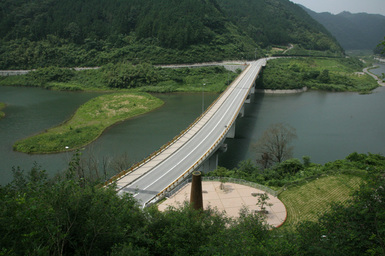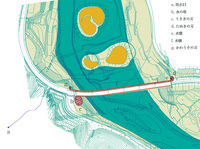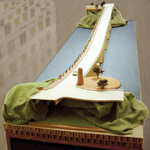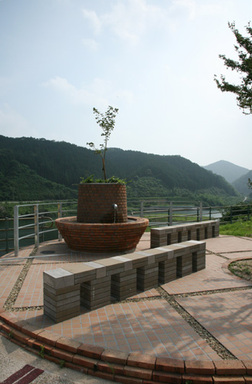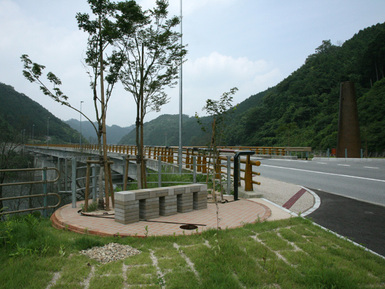Ototoi Bridge (Hajioohashi)
Oval-shaped park, water circulation system, bridge railing and pavement design
Location : Kiya, Soryo-cho, Syobara-shi, Hiroshima
Length : 190m
Width : 11m
Completion : 2007
Hajibashi, constructed as part of an ancillary work of the Haizuka dam, is the longest bridge in the dam area. Its purpose is to let the prefectural highway pass over the reservoir in the upstream of the secondary dam which is to be built in the Tabusagawa River for water control within the area. However, the construction of a reservoir in the Tabusagawa River involved the risk of turning the stream flowing into the river from the surrounding valleys (Otani) into wastewater.
The construction of the bridge itself could no longer be reconsidered. Thus, the problem was how to transform the environmental role and meaning of the bridge by reassembling solely the functional linkages (and shapes) of its facilities such as the bridge rail, pavement and surrounding park. In addition, how to restore the organic linkage with the dissected living area also became an issue for the project. Needless to say, the basic concept is the recovery and reutilization of the streams of Otani (e.g., provide solace to the bridge passers and use it as the irrigation water for afforestation) which had formally been used as daily life water in the local community, supplying an important water source connected closely to the lives of people. Moreover, the stream took precedence in giving the new bridge its distinct characteristic.
ground plan model
○ The plan: river running above river = new aqueduct
Hajibashi is an angled bridge with an inclination pitch of 3% from downstream to upstream, and a 6m difference of elevation from the opposite bank. A tower with a height (7.5m) just over this difference of elevation was constructed in the park on the downstream side, and the water irrigated from the streams of Otani was gathered there. The gathered water crosses the bridge from the tower to the opposite bank, rising up a slope of 190m through a pipe set within the bridge rail. Then it turns around and comes back to the downstream park through the balustrade pipe (water shoot) set alongside the pavement, and is released into the Tabusagawa River (Nakatsukunibuchi) through the retarding gutter. The water running inside the balustrade produces various sounds through a device set within the pipe, and can also be used for irrigating the plants. It cools off the passersby in the scorching heat and provides bounty for the nature. The objects that produce the secret sounds from the balustrade (Ototoi = sound water shoot) were set by the ingenuity of the local people.
The flow of water passes through three parks in the shape of an animal ear while rising up the bridge and coming back. These parks are named "Rabbit's ear," "Raccoon dog's ear," and "Otter's ear," and benches are placed in each of them for listening to the sound and breath of nature.
Rabbit's ear
Raccoon dog's ear
Otter's ear

